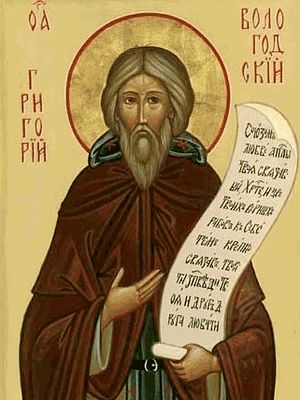Saint Gregory of Pelsheme, Vologda, was born in the city of Galich, Kostroma governia. He came from the line of the Lopotov nobility. When the youth reached age fifteen, his parents wanted him to marry, but they died, without seeing this come to pass. Young Gregory distributed the inheritance left him to the poor, and entered the monastery of the Most Holy Theotokos on the shore of Lake Galich.
The Igumen of the monastery regarded the new monk with mistrust because of his youth and noble parentage. Therefore, he placed Gregory in obedience to an experienced Elder. With great humility Saint Gregory served all the brethren. After a certain while he was ordained a priest. Soon Saint Gregory’s fame as a pastor spread, and many began to arrive for spiritual guidance and counsels.
The Galich prince asked the monk to be godfather for his children. Burdened by fame and the nearness of his relatives, the monk went to Rostov to venerate the relics of Saint Leontius (May 23), and he settled in the monastery of Saint Abramius, (October 29). But here also news of the saint’s ascetic feats quickly spread.
The monks of the Savior (Yakovlev) monastery turned to Archbishop Dionysius of Rostov (1418-1425) with a request to assign Saint Gregory to head their monastery. Out of humility the monk accepted the guidance over the monastery, but after two years he secretly left the monastery and withdrew into the Vologda forest.
In the Sosnovetsk wilderness he became acquainted with Saint Dionysius of Glushitsa (June 1). When the Lord prompted the holy ascetic to found his own monastery, Saint Dionysius approved his friend’s intention. With a cross on his shoulders, Saint Gregory crossed over the River Pelsheme and planted the cross in a thicket by the river bank.
The first monk in the new monastery was the priest Alexis, in monasticism Alexander. In 1426 a church was built at the monastery in honor of the Most Holy Theotokos. Its icons were painted by Saint Dionysius, and Saint Gregory himself copied the sacred texts for the monastery. Gradually the number of monks increased, the monastery grew and became more famous.
Saint Gregory concerned himself with the nurturing of piety at the monastery, and at the same time he shared in the destiny of his country. In the year 1433, he went to Moscow in order to prevail upon the Galich prince Yuri Dimitrievich, who had seized the Moscow principality from Basil the Dark, to return Moscow to Prince Basil. Prince Yuri obeyed the monastic Elder.
But in 1434 the son of Prince Yuri, Demetrius Shemyaka, began to ravage the Vologda lands belonging to the Great Prince. Saint Gregory, distraught over the discord and violence, went to Demetrius Shemyaka and addressed him with bold words. “Prince Demetrius,” said the monk, “you do things that are not Christian. It would be better if you had gone into a pagan land to a vile people ignorant of God. Widows and orphans cry out against you to God. How many people will perish from hunger and cold because of you, and if you don’t stop the fratricide, the bloodshed and violence soon, then you shall lose both your glory and your princedom.”
After this bold denunciation, Shemyaka gave orders to throw the holy Elder off a bridge. For several hours the monk lay there unmoving. His denunciations produced the desired effect, and Shemyaka soon quit Vologda. The courage of the monk only increased the veneration of him. Before his death, he received the Holy Mysteries, spoke a word of guidance to the brethren, and appointed as igumen of the monastery his fellow ascetic Alexander. Saint Gregory reposed on September 30, 1442 and was buried in the monastery he founded.

